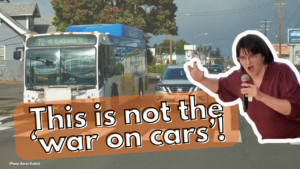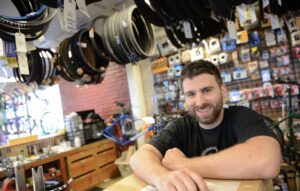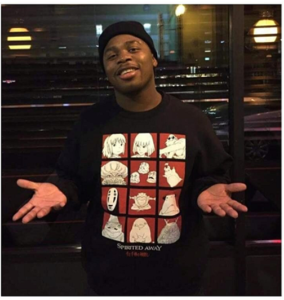Revisiting Yo La Tengo’s Oh So Portland ‘Old Joy’ Score

The Portland-founded label Mississippi Records is releasing Yo La Tengo’s Old Joy score for the first time on vinyl.
No director has captured what Oregon, and specifically Portland, feels like better than Kelly Reichardt. Showing Up, her 2023 movie about the unrewarding life of an artist with a day job, bottled the city’s atmosphere in the present tense. It replaced, or updated, the space another of her films held in my mind. Way back in 2006, Reichardt pulled off a similar trick with Old Joy. She used her beautiful sensitivity to the granular texture of this place and its people to turn a buddy road trip flick into a deeply affecting record of a pivotal moment, for the movie’s characters, the city, and the country. Reichardt’s script and images captured the city’s mien. But she bolstered them with a sweet little collection of Yo La Tengo songs that feel at once oh so very 2006 and impressively timeless. On February 28, the Portland-founded label Mississippi Records is releasing those songs for the first time on vinyl—a sparkly and vast six instrumental tracks the band apparently put to tape on a single afternoon way back when.
The release fits nicely into the label’s larger project. Though based out of New York today, Mississippi Records started in the North Albina record store of the same name and has done loads of work to preserve Portland’s musical history, publishing and rereleasing out-of-print records by Ural Thomas, Dead Moon, Michael Hurley, and countless others, many of which would have otherwise been lost to time. That said, no geographical borders dictate its output. Last year, it ventured into dug-from-the-archives motion picture soundtracks, starting with the score from Chess of the Wind, a twice-banned Iranian film from 1976 the Criterion Collection calls a “rediscovered jewel.” Scorsese was involved in the restoration, reportedly working from a single existing pressing discovered by chance in a thrift shop.

Will Oldham, a.k.a. Bonnie “Prince” Billy (left), and Daniel London in Old Joy.
It wouldn’t be fair to compare Chess of the Wind to Old Joy, but Reichardt’s message is far more complex than her harmless plot—two old friends reuniting for a jaunt to Bagby Hot Springs—would have you believe. Reviewing the movie in The New York Times, Manohla Dargis called it “a triumph of modesty and of seriousness that also happens to be one of the finest American films of the year.” On its face, Old Joy is about the confusing sorrow of realizing you can never go home again. But Dargis spent most of her words contextualizing the film’s socio-political overtones. No other film, she wrote, captured “the tenor of these difficult times with more sensitivity or greater attention to beauty.” A constant stream of Air America playing on the car radio holds Mark (Daniel London) like a dull ground current: relentless bad news keeps him informed, however powerless he is, and tethers him to society throughout the excursion. Two decades later, public radio is child’s play, as far as droning information systems go. But the way Mark plugs into it each time he gets in the car foreshadows the gross relief of checking your phone after the world has kept you from it for longer than you can bear.

Oldham and London visiting Bagby Hot Springs, as seen in Old Joy.
The movie has layer upon layer of intrigue for any music nerd, too. For starters, though he’s strictly acting here, Will Oldham, a.k.a. Bonnie “Prince” Billy, costars alongside London. Oldham is a bushy-bearded Peter Pan with a little glass weed pipe; London wears a clean shave and has a baby on the way. As far as the music goes, if the Yo La Tengo score wasn’t enough of a draw, Americana guitarist Smokey Hormel teamed up with the band for the project. Hormel is known for playing on movie scores like David Lynch’s The Straight Story and Todd Haynes’s shape-shifting Bob Dylan movie I’m Not There, as well as a handful of Beck records and Johnny Cash’s later work, including that one Nine Inch Nails cover.

Yo La Tengo: Georgia Hubley (left), Ira Kaplan, and James McNew.
Yo La Tengo previously released the Old Joy score on a CD collecting its film work, cleverly titled They Shoot, We Score. But this is its first release as an isolated motion picture soundtrack. Cyrus Moussavi, head of Mississippi Records, says the project came together with shocking ease. After the Chess of the Wind project, Sam Wenc, a designer and composer who works at the label, suggested looking into the Old Joy soundtrack on a lark. Moussavi remembers Eric Isaacson, who founded the label, saying “Well, I’m buddies with all those people,” meaning Reichardt, the film’s screenwriter Jon Raymond, and the members of Yo La Tengo. “We literally emailed all of them on one thread,” Moussavi says, “and they were all like, ‘That’s awesome. Go for it.’”
That flow seems to mirror how the film itself came together. Old Joy marked the beginning of Reichardt’s long collaboration with Raymond, with whom she’s now made seven films. “I didn’t think it would be a feature,” Reichardt told Interview Magazine last year, reflecting on the beginnings of the project. “[I]t was just an art project.” Running a quick but satisfying 76 minutes, Old Joy has the ease and immediacy of such an art project; it’s charming and truer to life because of its modest production—a reported $30,000 budget—not constrained.
Old Joy was only Reichardt’s second movie, and it set her tone of voice as a filmmaker. There’s something below the surface signaling she made each of her movies, even though her marks are so much subtler than more ostentatious stylists—a Wes Anderson or Quintin Tarantino. “There’s an atmosphere,” says Moussavi, who is also a filmmaker, “you know it instantly when you see it, [but] you’re not quite sure what it is.” Likewise, Moussavi says, the Old Joy soundtrack is instantly recognizable to any Yo La Tengo fan, but, lacking singer Ira Kaplan’s distinctive vocals, it’s hard to put your finger on why exactly that is.

Though it could accurately be called a buddy road trip movie, Old Joy is intricately woven with layered meaning.
Yo La Tengo has always managed to create a gigantic, wide-open sound using the most basic instrumentation: drums, bass, and guitar absent of any conspicuous effects, distortion, or production magic. Like the film’s free-flowing mood, the score’s impromptu compositions retain their freshness almost two decades on. There’s reassurance in their noodley structures—bounding jams that chug along confidently and eventually find a kind of symmetry. They move to a conversational rhythm rather than a metronome’s, and seem to open ever wider and wider, teetering on the edge of any recognizable framework, before resolving pleasantly, like getting lost in a familiar place but still managing to make it home for dinner.
The songs and the movie still buzz with life today, distinctly of their time but also existing outside of time. By 2009, another New York Times critic, A.O. Scott, placed Reichardt at the forefront of what he called “neo-neo realism,” a hyper attenuated approach to filmmaking focused on the immediacy of daily life—movies for when “we feel an urge to escape from escapism.” Like Yo La Tengo and Hormel’s jam session, the style requires an extreme confidence of the filmmaker’s hand, capable of transforming the quotidian into an important cultural document. Moussavi says Old Joy seemed to “vibrate” on the screen at a recent New York screening promoting the record: “Everyone was like, ‘I know that feeling, and it’s right there!’” But, of course, it wasn’t. “What seemed so normal,” Moussavi added, “now feels really far away.”
Share this content:















Post Comment